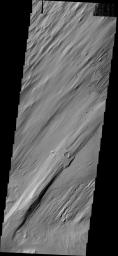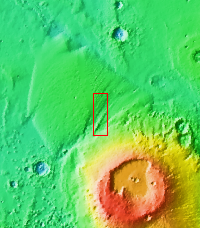
|
Wind Erosion
- Click the image above for a larger view
- Full-Res JPEG (1346 x 2924) (436.9 kB)
- Full-Res TIFF (1346 x 2924) (3.9 MB)
Caption:
When a large impact occurs it vaporizes the surface and deposits hot debris around the newly formed crater. That change of the surface by an impact is beautifully illustrated here, where the crater and ejecta are more resistant to the power of the wind. Note the other smaller craters near top of the image. This image is located on the northern flank of Apollinaris Mons.
Orbit Number: 45122 Latitude: -6.8759 Longitude: 173.689 Instrument: VIS Captured: 2012-02-15 12:49
Background Info:
Please see the THEMIS Data Citation Note for details on crediting THEMIS images.
NASA's Jet Propulsion Laboratory manages the 2001 Mars Odyssey mission for NASA's Science Mission Directorate, Washington, D.C. The Thermal Emission Imaging System (THEMIS) was developed by Arizona State University, Tempe, in collaboration with Raytheon Santa Barbara Remote Sensing. The THEMIS investigation is led by Dr. Philip Christensen at Arizona State University. Lockheed Martin Astronautics, Denver, is the prime contractor for the Odyssey project, and developed and built the orbiter. Mission operations are conducted jointly from Lockheed Martin and from JPL, a division of the California Institute of Technology in Pasadena.
Cataloging Keywords:
| Name | Value | Additional Values |
|---|---|---|
| Target | Mars | |
| System | ||
| Target Type | Planet | |
| Mission | 2001 Mars Odyssey | |
| Instrument Host | Mars Odyssey | |
| Host Type | Orbiter | |
| Instrument | Thermal Emission Imaging System (THEMIS) | |
| Detector | ||
| Extra Keywords | Crater, Grayscale, Impact, Mountain, Thermal | |
| Acquisition Date | ||
| Release Date | 2012-03-29 | |
| Date in Caption | 2012-02-15 | |
| Image Credit | NASA/JPL/ASU | |
| Source | photojournal.jpl.nasa.gov/catalog/PIA15469 | |
| Identifier | PIA15469 | |

